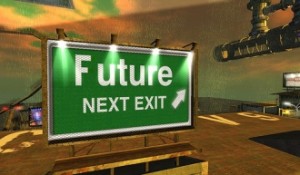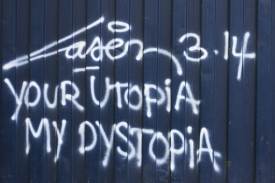I’ve just found word of a great exhibition being held at the moment in New York – called ‘Toward the Sentient City’ – which showcases various reactions to the future use of technology in society. There are some great installations set up, many of which blur the line between art and prototype fantastically well. The purpose of the exhibition is to create discussion about how future technologies might be used, and explore both the positive and negative effects that might be the result.
Benches that tip people off for sitting on them too long; recycle bins that throw your trash back out at you if it is unsuitable; an array of houseplants which get killed off if you use too much electricity and thrive if you are frugal. These are just a few of the fascinating ideas that are part of the exhibition, and I really do wish it wasn’t on the other side of the globe so that I could go and see it!
Even though many of the pieces in this exhibition seem fanciful, and many are certainly exaggerated for impact, the fact is that we are going to be seeing a lot more technology on a day-to-day basis. I’m not just referring to technology in the manner that we use it right now, although that too will truly be magnified, but instead I’m referring to efforts to make the objects we use and environments we exist in more intelligent and adaptive.
Examples of fridges that monitor the food inside them are well known – and such ideas will certainly extend into basically every part of our lives. We are used to seeing other people adapt to how we behave, to respond and react accordingly, but are we ready to have what were previously inanimate objects begin to do the same? Personally, I think there are countless fantastic applications that can, and will, emerge out of this ‘object sentience’ stream of progress.
However, there are also very clearly some danger areas involved in automating everything – particularly when it comes down to things such as social profiling and service refusal. As is mentioned in the article linked above, what happens when the turnstiles at a train station don’t open for you because you fit the patterned travel behaviour of a ‘terrorist’. How about having your purchases tracked and collated, or the contents of your rubbish bin analysed and run through a central computer for signs of anything considered contraband?
As I’ve said before here on Future Conscience, and will continue to say, what is required is constant vigilance and awareness of the avenues of progress that are being made. Not just awareness by those creating such things – although that certainly is needed – but also on a wider, mainstream level of consciousness. We can no longer just allow ourselves to be ignorant of such developments, because things are going to progress at such a rapid rate that we could very quickly find ourselves in a dystopian society without much prior warning.
On the flip-side, we could also enter into a more utopian civilization; where our daily worries are chores are no longer relevant, allowing us more free time to do the things that allow us to flourish. In the end, it is going to be a mixture of both – there will be good and bad, because the technology itself is inherently neutral…it’s just that the people who create and use it are everything but.
[ad name=”Google Adsense-Link Banner x4″]






